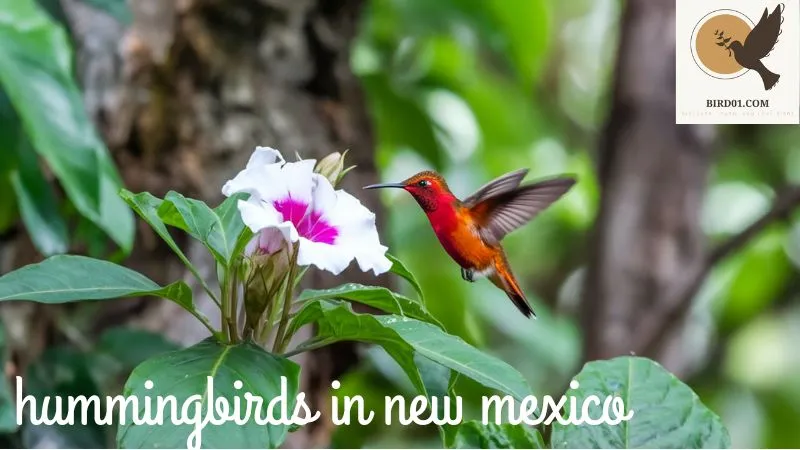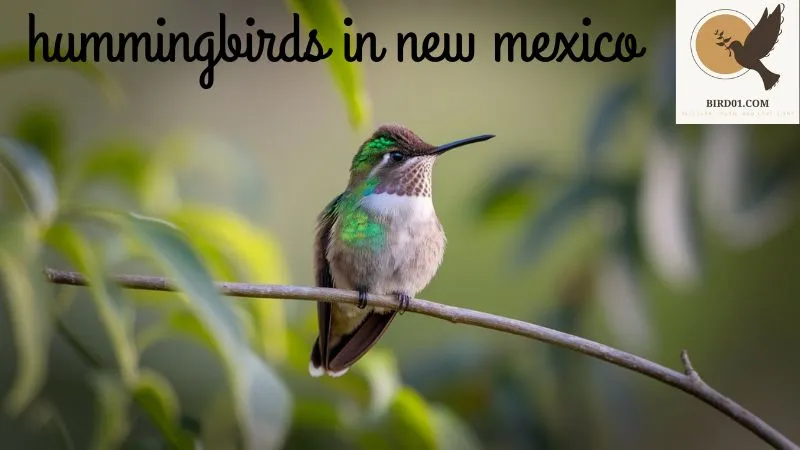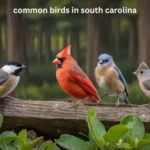Bird Identification
Hummingbirds in New Mexico: A Jewel in the Desert Skies
New Mexico is known for its breathtaking landscapes, rich cultural heritage, and incredible biodiversity. Among its most fascinating inhabitants are the hummingbirds, tiny creatures that captivate bird enthusiasts and nature lovers alike. These energetic and colorful birds are not only a beautiful part of New Mexico’s ecosystem but also serve as an essential component of its natural environment. This article, brought to you by Bird01.com, explores the world of hummingbirds in New Mexico, discussing the species commonly found in the region, their migratory patterns, habitats, and how to attract and care for them in your backyard.
A Hummingbird Haven: New Mexico’s Unique Environment
New Mexico’s diverse climate and ecosystems—ranging from arid deserts to mountainous forests—make it an ideal habitat for a variety of hummingbird species. The state’s location in the Southwest United States places it in the migratory path of many hummingbird species, making it a key stopover for these tiny travelers. With its abundance of flowering plants and insects, New Mexico offers the perfect conditions for hummingbirds to thrive.
Why New Mexico Attracts Hummingbirds
Hummingbirds are highly dependent on nectar-rich flowers, and New Mexico’s unique flora provides an abundance of food sources. Native plants such as red yucca, desert willow, and penstemon are perfect for these nectar feeders, while the state’s numerous water sources and gardens attract them during their migrations. The wide-open landscapes also offer plenty of space for hummingbirds to build nests and raise their young.
The State’s Role in Hummingbird Migration
One of the key reasons why New Mexico is such a popular spot for hummingbirds is its location along migratory routes. Every year, hummingbirds migrate between their breeding grounds in North America and their wintering grounds in Central and South America. During these journeys, many hummingbird species stop in New Mexico to refuel on nectar before continuing their long flights. Some species even breed in the state, making it a year-round hummingbird hotspot.
Hummingbird Species Found in New Mexico
New Mexico is home to several species of hummingbirds, each with its own unique characteristics. While some species are year-round residents, others are seasonal visitors during migration.
1. Black-chinned Hummingbird (Archilochus alexandri)
One of the most common hummingbirds in New Mexico, the black-chinned hummingbird is a small bird with a metallic green back and a white underside. Males are easily recognized by their black chin and iridescent violet throat patch, which shimmers in the sunlight. Black-chinned hummingbirds are highly adaptable, often found in urban areas, woodlands, and deserts. They are also frequent visitors to hummingbird feeders in backyards.
2. Broad-tailed Hummingbird (Selasphorus platycercus)
The broad-tailed hummingbird is another frequent visitor to New Mexico, especially in mountainous regions. Males have a striking iridescent rose-colored throat, while females and juveniles are duller with green backs and white bellies. This species is particularly well adapted to cooler climates, often found at higher elevations in pine forests and meadows. During migration, broad-tailed hummingbirds may travel as far as Central America.
3. Rufous Hummingbird (Selasphorus rufus)
Renowned for its feisty nature and vivid orange coloring, the rufous hummingbird is one of the more aggressive species in New Mexico. Males are a brilliant reddish-orange, while females are slightly paler with green backs. Rufous hummingbirds are known for their long migratory routes, traveling from as far north as Alaska to Mexico during the winter. They pass through New Mexico in late summer and fall, often engaging in territorial disputes at feeders.
4. Calliope Hummingbird (Selasphorus calliope)
The calliope hummingbird is the smallest bird found in the United States, yet it undertakes a long migration each year. Males are distinguished by their unique magenta streaks on their throat, while females have a simpler appearance with greenish backs and light-colored bellies. Calliope hummingbirds are usually found in high-altitude habitats, preferring open meadows and mountainous areas. Although less common than other species, they make their presence known during migration.
5. Anna’s Hummingbird (Calypte anna)
While more common along the Pacific Coast, Anna’s hummingbird can occasionally be found in southern parts of New Mexico. This species is one of the few hummingbirds that do not migrate extensively, often staying year-round in temperate areas. Males are recognizable by their iridescent pinkish-red throats and crowns, while females are generally duller in color. Though less frequent in New Mexico, their distinctive song and bright plumage make them a memorable sight for birdwatchers.
6. Broad-billed Hummingbird (Cynanthus latirostris)
A stunning species with vibrant blue and green plumage, the broad-billed hummingbird is occasionally seen in southern New Mexico. Males boast a brilliant blue throat and green body, while females have a more subdued appearance. Broad-billed hummingbirds prefer desert habitats and are often found near streams and arid canyons. While they are not as common as other species, their striking appearance makes them highly sought after by birdwatchers.

Hummingbird Migration in New Mexico
One of the most remarkable aspects of hummingbirds is their migration patterns. Each year, millions of hummingbirds embark on long journeys between their breeding and wintering grounds. For many species, New Mexico serves as a critical stopover during this migration, providing much-needed food and rest.
When Do Hummingbirds Migrate Through New Mexico?
Migration typically begins in early spring, with most hummingbirds arriving in New Mexico between late March and early April. The migration continues through the summer months, with some species breeding in the state. By late summer and early fall, species like the rufous hummingbird make their way south, heading toward Mexico and Central America.
The Role of Backyard Feeders in Migration
Backyard feeders play an important role in supporting hummingbirds during migration. As these tiny birds expend enormous amounts of energy during their long flights, feeders provide a reliable source of nectar to help them refuel. In New Mexico, many bird enthusiasts set up feeders in their yards, particularly during peak migration seasons.
To attract migrating hummingbirds, it’s important to maintain clean, fresh feeders filled with a homemade nectar solution (4 parts water to 1 part sugar). Avoid using red dye or store-bought nectar, as it may harm the birds. By providing food, water, and shelter, homeowners can play a vital role in helping hummingbirds complete their arduous journeys.
The Habitat of Hummingbirds in New Mexico
New Mexico’s diverse ecosystems provide hummingbirds with a variety of habitats. From the high-altitude forests of the Sangre de Cristo Mountains to the arid deserts of the Chihuahuan Desert, hummingbirds can be found in nearly every corner of the state.
High-Elevation Forests and Meadows
Broad-tailed and calliope hummingbirds are often found in New Mexico’s mountainous regions, where cooler temperatures and abundant flowers create ideal breeding grounds. The state’s high-elevation meadows are filled with nectar-rich flowers that hummingbirds rely on during the summer months.
Desert Habitats
Hummingbirds such as the black-chinned and broad-billed species are well-adapted to the desert environment. The arid landscapes of southern New Mexico provide these birds with plenty of blooming cacti and desert flowers, which produce ample nectar. In these regions, hummingbirds are often seen hovering around desert willows and agaves.
Urban Areas
Interestingly, hummingbirds have also adapted to urban environments. Many residents in New Mexico set up feeders and cultivate hummingbird-friendly gardens, making cities and towns ideal habitats for species like the black-chinned and Anna’s hummingbirds. Urban environments can provide hummingbirds with abundant food sources, particularly during migration.
How to Attract Hummingbirds to Your Backyard in New Mexico
New Mexico residents are fortunate to live in a state where hummingbirds are abundant. By making a few simple changes to your backyard, you can attract these dazzling birds and enjoy their presence throughout the year.
1. Plant Native Flowers
One of the best ways to attract hummingbirds is by planting native, nectar-rich flowers. Species such as columbine, penstemon, honeysuckle, and red yucca are particularly attractive to hummingbirds. These plants not only provide food but also enhance the natural beauty of your garden.
2. Provide Fresh Water
Hummingbirds need water not only for drinking but also for bathing. Installing a shallow birdbath or a small fountain can help attract hummingbirds to your yard. Moving water is particularly appealing to hummingbirds, so a fountain with a gentle flow is ideal.
3. Set Up Feeders
Placing feeders around your yard is a great way to attract hummingbirds, especially during migration. Be sure to use a nectar solution made from sugar and water, and clean the feeders regularly to prevent mold or bacteria buildup.
4. Create Perches and Shelters
Hummingbirds need places to rest, particularly after long flights. By adding shrubs, trees, and trellises, you can create perching spots where hummingbirds can take breaks between feedings.
Conclusion
Hummingbirds are among the most enchanting creatures in New Mexico, bringing color and energy to the state’s diverse landscapes. From the black-chinned hummingbirds that visit urban feeders to the rare sightings of broad-billed hummingbirds in the desert, these tiny birds captivate the hearts of bird lovers across the state. By understanding their migratory patterns, habitats, and needs, New Mexico residents can play an active role in supporting hummingbirds throughout their journeys. Whether you’re a seasoned birder or simply enjoy watching wildlife in your backyard, the hummingbirds of New Mexico are sure to provide endless joy and fascination. For more tips on birding and attracting hummingbirds, be sure to visit Bird01.com, your go-to source for all things bird-related.






